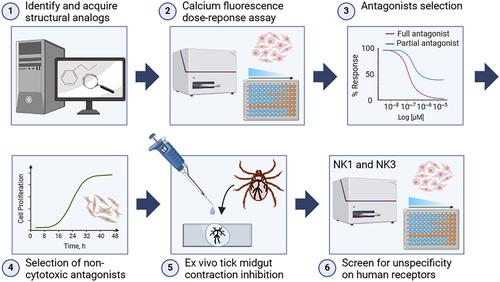当前位置:
X-MOL 学术
›
Pest Manag. Sci.
›
论文详情
Our official English website, www.x-mol.net, welcomes your feedback! (Note: you will need to create a separate account there.)
Target‐based discovery of antagonists of the tick (Rhipicephalus microplus) kinin receptor identifies small molecules that inhibit midgut contractions
Pest Management Science ( IF 3.8 ) Pub Date : 2024-06-20 , DOI: 10.1002/ps.8242 Bianca Monteiro Henriques-Santos 1 , Dwight Baker 2 , Nian Zhou 2 , Thomas Snavely 2 , James C Sacchettini 2 , Patricia V Pietrantonio 1
Pest Management Science ( IF 3.8 ) Pub Date : 2024-06-20 , DOI: 10.1002/ps.8242 Bianca Monteiro Henriques-Santos 1 , Dwight Baker 2 , Nian Zhou 2 , Thomas Snavely 2 , James C Sacchettini 2 , Patricia V Pietrantonio 1
Affiliation

|
BACKGROUNDA GPCR (G protein‐coupled receptor) target‐based approach was applied to identify antagonists of the arthropod‐specific tick kinin receptor. These small molecules were expected to reproduce the detrimental phenotypic effects that had been observed in Rhipicephalus microplus females when the kinin receptor was silenced by RNA interference. Rhipicephalus microplus , the southern cattle tick, cattle fever tick, or Asian blue tick, is the vector of pathogenic microorganisms causing the deadly bovine babesiosis and anaplasmosis. The widespread resistance to acaricides in tick populations worldwide emphasizes that exploring novel targets for effective tick control is imperative.RESULTSFifty‐three structural analogs of previously identified tick kinin antagonists were screened in a ‘dual‐addition’ calcium fluorescence assay using a CHO‐K1 cell line expressing the tick kinin receptor. Seven molecules were validated as non‐cytotoxic antagonists, four of which were partial (SACC‐0428764, SACC‐0428780, SACC‐0428800, and SACC‐0428803), and three were full antagonists (SACC‐0428799, SACC‐0428801, and SACC‐0428815). Four of these antagonists (SACC‐0428764, SACC‐0428780, SACC‐0428799, and SACC‐0428815) also inhibited the tick midgut contractions induced by the myotropic kinin agonist analog 1728, verifying their antagonistic bioactivity. The small molecules were tested on recombinant human neurokinin (NK) receptors, the one most similar to the invertebrate kinin receptors. Most molecules were inhibitors of the NK1 receptor, except SACC‐0412066, a previously identified tick kinin receptor antagonist, which inhibited the NK1 receptor only at the highest concentration tested (25 μm ). None of the molecules inhibited the NK3 human receptor.CONCLUSIONMolecules identified through this approach could be useful probes for studying the tick kinin signaling system and midgut physiology. © 2024 The Author(s). Pest Management Science published by John Wiley & Sons Ltd on behalf of Society of Chemical Industry.
中文翻译:

基于靶标的蜱(微小扇头蜱)激肽受体拮抗剂发现识别出抑制中肠收缩的小分子
背景 GPCR(G 蛋白偶联受体)基于靶标的方法用于鉴定节肢动物特异性蜱激肽受体的拮抗剂。这些小分子预计会重现在微小扇头扇贝当激肽受体被 RNA 干扰沉默时微小扇头扇贝南方牛蜱、牛热蜱或亚洲蓝蜱是引起致命牛巴贝斯虫病和无形体病的病原微生物媒介。全世界蜱虫群体对杀螨剂的广泛耐药性强调,探索有效控制蜱虫的新靶点势在必行。 结果使用 CHO-K1 细胞,通过“双加法”钙荧光测定筛选了先前鉴定的蜱激肽拮抗剂的 53 个结构类似物表达蜱激肽受体的细胞系。七种分子被验证为非细胞毒性拮抗剂,其中四种是部分拮抗剂(SACC-0428764、SACC-0428780、SACC-0428800 和 SACC-0428803),三种是完全拮抗剂(SACC-0428799、SACC-0428801 和 SACC) ‐0428815)。其中四种拮抗剂(SACC-0428764、SACC-0428780、SACC-0428799 和 SACC-0428815)也抑制肌激肽激动剂类似物 1728 诱导的蜱中肠收缩,验证了它们的拮抗生物活性。这些小分子在重组人神经激肽(NK)受体上进行了测试,这是一种与无脊椎动物激肽受体最相似的受体。大多数分子都是 NK1 受体的抑制剂,但 SACC-0412066 除外,SACC-0412066 是一种先前鉴定的蜱激肽受体拮抗剂,仅在测试的最高浓度(25 μ米)。 这些分子均不抑制 NK3 人类受体。结论通过这种方法鉴定的分子可作为研究蜱激肽信号系统和中肠生理学的有用探针。 © 2024 作者。害虫管理科学由 John Wiley & Sons Ltd 代表化学工业协会出版。
更新日期:2024-06-20
中文翻译:

基于靶标的蜱(微小扇头蜱)激肽受体拮抗剂发现识别出抑制中肠收缩的小分子
背景 GPCR(G 蛋白偶联受体)基于靶标的方法用于鉴定节肢动物特异性蜱激肽受体的拮抗剂。这些小分子预计会重现在微小扇头扇贝当激肽受体被 RNA 干扰沉默时微小扇头扇贝南方牛蜱、牛热蜱或亚洲蓝蜱是引起致命牛巴贝斯虫病和无形体病的病原微生物媒介。全世界蜱虫群体对杀螨剂的广泛耐药性强调,探索有效控制蜱虫的新靶点势在必行。 结果使用 CHO-K1 细胞,通过“双加法”钙荧光测定筛选了先前鉴定的蜱激肽拮抗剂的 53 个结构类似物表达蜱激肽受体的细胞系。七种分子被验证为非细胞毒性拮抗剂,其中四种是部分拮抗剂(SACC-0428764、SACC-0428780、SACC-0428800 和 SACC-0428803),三种是完全拮抗剂(SACC-0428799、SACC-0428801 和 SACC) ‐0428815)。其中四种拮抗剂(SACC-0428764、SACC-0428780、SACC-0428799 和 SACC-0428815)也抑制肌激肽激动剂类似物 1728 诱导的蜱中肠收缩,验证了它们的拮抗生物活性。这些小分子在重组人神经激肽(NK)受体上进行了测试,这是一种与无脊椎动物激肽受体最相似的受体。大多数分子都是 NK1 受体的抑制剂,但 SACC-0412066 除外,SACC-0412066 是一种先前鉴定的蜱激肽受体拮抗剂,仅在测试的最高浓度(25 μ米)。 这些分子均不抑制 NK3 人类受体。结论通过这种方法鉴定的分子可作为研究蜱激肽信号系统和中肠生理学的有用探针。 © 2024 作者。害虫管理科学由 John Wiley & Sons Ltd 代表化学工业协会出版。
















































 京公网安备 11010802027423号
京公网安备 11010802027423号